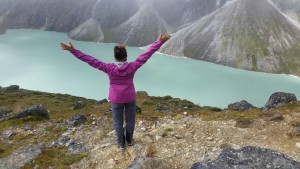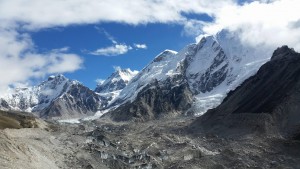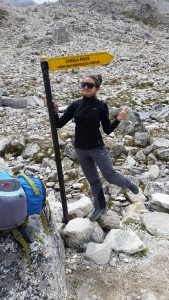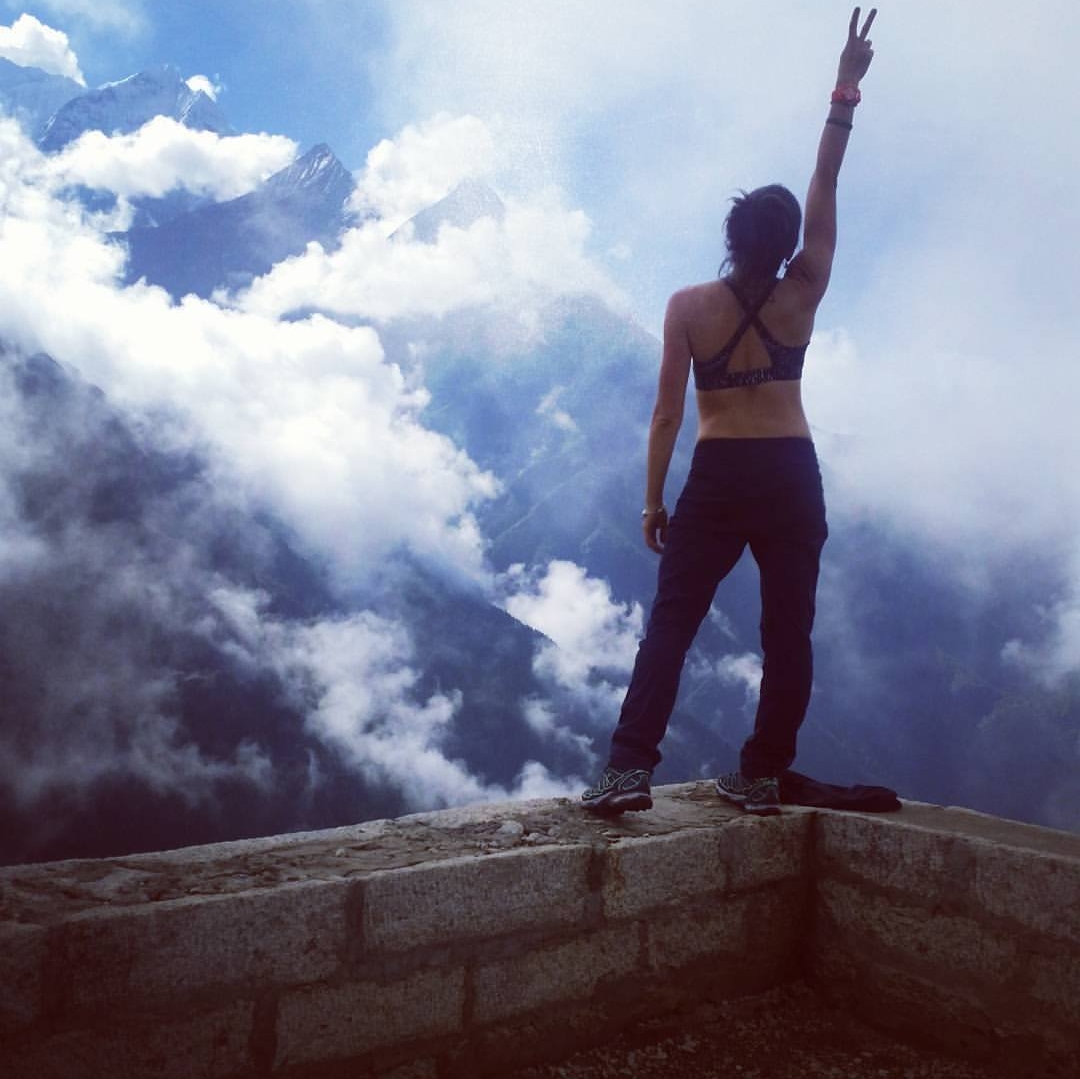Life…our greatest adventure. Sometimes the adventure is hidden far below the rules and routines of our lives, but if we let go and take chances to really chase the adventurous spirit within, we may just find out who we really are, just like Sasha Maricheva…..
‘You can never tell to what untold glories any little humble path may lead if you follow far enough’.
I started running a year ago and until that time I would never ever have pictured myself trekking in the Himalayas. You think it’s not really connected? I think it is.
My life has changed a lot since I started running. In the last year I ran my first marathon and did my first trail run. I fell in love with the later – the wild running experience where you can feel so free – it’s just yourself, beautiful landscapes, running friends beside you and bright trail shoes. Oh and that hot rewarding hot chocolate afterwards. Definitely a large one! Trails are never short distances, so it’s well deserved. Thus I thought trekking in the mountains is something all trail runners dream about.
I haven’t been on holidays since I separated, in 2 years to be precise. So yeah I was feeling like something nice and easy. Bali for example. Then I thought since I love trails so much, trekking in the Himalayas would be a good idea.
Also mountains sounded like a great adventure. I’ve never done any trekking though, neither had I been to the mountains before. It was decided: Nepal.
I quickly shopped for all my gear as I had nothing. Then I packed and waited until the beginning of September came. I had heard people talking about altitude sickness a lot, asking me if I was ready for it. They even asked me if trained for it? How on earth can you be trained for altitude sickness? What is this altitude sickness anyway? I couldn’t be bothered to Google it. I’m a marathoner I thought – a tough girl – I’d be just fine.
The tour organiser advised me that I was going to be by myself with a guide only a day before the departure (I was supposed to trek in a group). I’d never done solo travelling and it could be another out-of-my-comfort-zone thing to be ticked off. Great! The only thing I worried before I landed in Nepal was how I was going to survive without running and gym during those 3 weeks of holiday! My strong running friends who have been to the Himalayas said that I wouldn’t be able to run there. I don’t remember the last time I listened to anyone, so I packed my running shoes and was ready to go.

The minute when the airplane landed in Lukla (a small town from where most of the Himalayan tracks start) my heart started to pump as never before and I was a bit out of breath while walking. I walked fast – of course I did. For the first 4 days I trekked way too fast and had just a few short breaks. My guide told me to slow down. I never did. Until we arrived to Gokyo which is 4800m above sea level – the highest point I’d ever been to. Then it hit me. That altitude sickness. I had a very severe headache. The guide said we had to go back so we would be at a lower altitude. The town we came from was 4-5 hours away. I couldn’t move. The guide was about to call a helicopter which should have taken me back to Lukla. I saw 5-6 rescue helicopters every day in the air since we started trekking. The end of the trip. The holidays I’d been looking forward for so long could possibly end on the 5th day of trekking. I started to cry, feeling so sorry for myself, for my whole life, for being a single parent, for being lonely, for being so sick that I couldn’t finish this trek. All of a sudden, all sorts of emotions just hit me. All the emotions I tried to hide while living my casual life back in Sydney because I was never used to showing my weaknesses. I couldn’t stop crying, but I did manage to ask through all these tears for altitude sickness tablets. I also promised to walk slow from now on, as soon as I would be able to walk. I promised to rest. This is how I learnt my lesson: you can do anything, but not everything. No matter how physically and mentally strong you are, altitude sickness can stop you in your tracks.

I had an extra rest day at Gokyo and felt great for the rest of 10 days of my trekking experience. I walked slowly behind my guide, and took as many breaks as I needed. I watched. I took pictures. I caught up my breath. I enjoyed the experience. I met so many interesting people, I listened to their stories. I took notes of their advice about where to travel next: Kilimanjaro? Patagonia? Climb the Island peak? Or maybe Ama Dablam? I’ll definitely Google all these places when I get back home.
These kind of people you meet in Nepal you won’t meet as often in your everyday life. They all have this adventurous spirit and it’s so contagious you can’t wait to start planning your new holiday. It’s not going to be Bali, you know that for sure!
I can write so much about Nepal but it might be a way too long, so here are some interesting facts about my experience in this beautiful country:
- The Nepalese cuisine is delicious. Menus at guest houses are amazing, mostly vegetarian. You can order meat dishes but you do it at your own risk. The Himalayas are the land of Buddhism, thus locals don’t kill animals up there. All meat you get is brought up from Kathmandu. Sometimes it takes days to bring meat up to villages.
- You trek around 6-7 hours every day and it’s tough. Not all trekkers finish their initially planned itineraries. Some walk back, some are transported by helicopters.
- There are days you have to wake up at 4am to start trekking early in order to get a good view of Everest.
- Most of the tourists are more or less affected by altitude sickness.
- You lose your appetite up in the mountains but you have to force yourself to eat.
- You don’t sleep well at night – it’s another sign of the altitude sickness.
- You don’t care that you are missing out on your running or gym training. You actually will be surprised how you’ve become physically stronger once you get back home and return to your training again. Also I managed to do a 1 hour run in the mountains. It felt great.
- All you talk about with strangers you meet at guest houses at the end of the day are other places to trek in the world, and what are you going to have for dinner. Or what you had for breakfast? And lunch? You will be surprised how basic your interests are: it’s all about sleep, rest, trekking and the meal. It feels right.
- Although you do have an opportunity to have a shower, you just can’t be bothered to shower in that cold weather. I didn’t have a shower in 9 days while trekking. It felt right.
- You see the highest mountain in the world and you’ll feel different about your life. I believe it’s a very personal thing but there’s something magic and powerful about Everest and the rest of the mountains.
- At the end of the trek you are a better version of yourself. You’ve been out of your comfort zone, physically, mentally and emotionally challenged. You’ve been in the Himalayas where not many people dare to dream of going.

I loved every single second of my trip to Nepal, including altitude sickness. It was definitely a lesson from the Universe. It’s also amazing how you start appreciating simple things like a hot shower, healthy food, electricity and free Wi-Fi – all these things we take for granted. I loved Nepal but I also was so excited to be back to my little son (I’ve never travelled without him before, and neither have I left him for that long), to Sydney beaches, running, training and my beloved trails, conveniently located stores and to my everyday routine.
I booked a trip to Uluru the day after I arrived home as it has been on my bucket list for a way too long. Oh and my next holiday will probably lead me to Africa to conquer Kilimanjaro. Also, Elbrus in Russia looks great in pictures… so many places to explore and I’m up for new adventures.


Wow that’s amazing. Thanks so much for the article. I’m going to Nepal in 4 weeks to trek in the Annapurna Ranges – can’t wait. Some great tips in there…